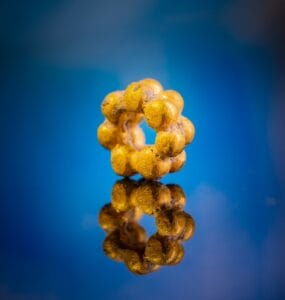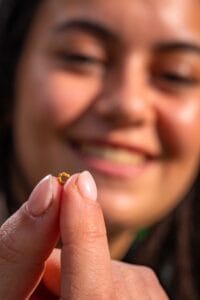(JNS)

This rare gold bead, dating back at least 1,600 years, was uncovered in dirt taken from a Roman structure in Jerusalem’s Emek Tzurim National Park. Photo courtesy ofAri Levy, Israel Antiquities Authority.
A unique, pure gold bead dating back at least 1,600 years has been uncovered in the Emek Tzurim National Park in Jerusalem, the Israel Antiquities Authority (IAA) recently announced.
The bead was found in dirt removed from a Roman structure discovered during the Pilgrimage Road Excavation. It was created using a unique technique that required delicate workmanship to affix tens of tiny balls together in the shape of a ring in order to create one ornament.
The relic was found by Hallel Feidman, an 18-year-old doing her compulsory national service as a volunteer for the sifting project at the Archaeological Experience.
“I poured the pail onto the sieve and began to wash the material that was brought from the excavations in the City of David,” she recounted. “And then I saw something shiny in the corner of the sieve, different, that I don’t normally see. I immediately approached the archaeologist, and he confirmed that I had found a gold bead. Everyone here was very excited.”

Hallel Feidman with the rare gold bead. Photo courtesy of Koby Harati, City of David.
Wealthy Area
According to IAA excavation directors Shlomo Greenberg and Ari Levy, the bead was found in a formerly grandiose structure that was at least 25 meters long and built on the Pilgrimage Road in the City of David. “The wealth of the building’s occupants is evidenced by additional finds that were discovered in it, like imported clay vessels and a decorated mosaic floor,” they said.
The researchers pointed out that the bead was perhaps created in a period that precedes that of the structure in which it was found, but said that it was reasonable to assume that the bead belonged to the building’s residents.
Complex Production
The find is of special importance, according to the researchers, both because gold items are rare archaeological finds in Israel and because beads of this style are not common, given the unique and complex technique used to create them.
The technique, researchers said, most probably originates from the region of Mesopotamia, where it was known approximately 4,500 years ago.
“The most interesting aspect of the bead is its unique and complex production method,” explained Amir Golani, an ancient jewelry expert at the IAA. “A good understanding of the materials and their properties is required, as well as control over the heat, in order to on the one hand solder the tiny balls together to create a tiny ring, while also preventing overheating which may lead all the gold to melt.”
It is possible that the bead was created in a different area and was brought to the City of David as part of the extensive trade relations between Jerusalem and other regions. Another theory is that the bead was gifted to a Jerusalem resident, or, possibly due to its unique nature, was passed within the family from one generation to another as an inheritance.
Similar beads have been discovered in burial caves from 2,500 years ago (end of the First Temple period) in Ketef Hinnom near the City of David, but those beads were made from silver.
To date, only a few dozen gold beads have been found in Israel.








